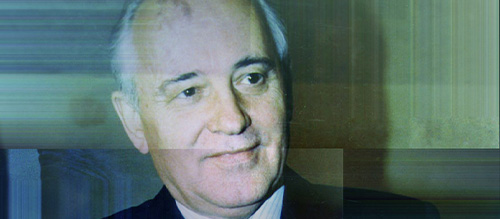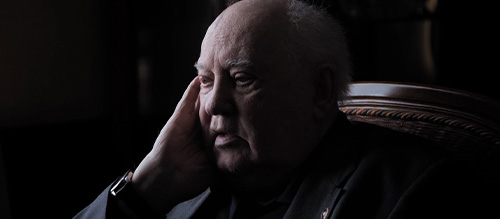Vitaly Mansky’s Two Gorbachevs
Every few years, the time comes to wheel out Tom Cruise for another big Hollywood payday. He is perhaps the perfect reboot fodder: all-action, scandal-proof (so far) and curiously impervious to aging. Mikhail Gorbachev (1931-2022), the final leader of the Soviet Union, is none of these things. And yet he is the subject of an unconventional cinematic ‘reboot’ in Russian-Ukrainian filmmaker Vitaly Mansky’s extraordinary duology of documentaries: Gorbachev. After Empire (2001) and Gorbachev. Heaven (2020). Reboots and sequels are usually more of the same, a way of further commercializing a film’s winning formula. But Mansky’s films instead display a profound change in their depiction of Gorbachev, one tied up with the transformations in Russian politics over the last two decades that has culminated in president Vladimir Putin’s revanchist invasion of Ukraine.
Before I delve into Mansky’s two films, I want to sketch out some Soviet slang. Sovok, Vatnik, and Homo Sovieticus, are three derogatory terms for Soviet yes-men with Soviet values, parroting politburo propaganda up until the very moment that the Iron Curtain melted away in 1991. In her 2013 book, “Secondhand Time”, Nobel Prize-winning writer Svetlana Alexievich recorded these sovok voices, so rarely heard in the West. They lament the shift to capitalism (“instead of a motherland, we live in a huge supermarket”) and the implosion of the USSR’s geopolitical influence (“everything that was once ours is now gone”). But Alexievich also tracks a change in tone after 2001 (with Putin now in power): “I’m learning how to be a free person. I don’t want to die the way I am now, all Soviet. I’m dredging the Sovietness out of myself by the bucketful…” Once people realized the Soviet status quo wasn’t coming back, purging the sovok from one’s soul became a key 21st Century political project in Russia.

In Mansky’s first Gorbachev film he portrays the former leader as trapped by the sovok spirit. In the opening shot of Gorbachev. After Empire, a red square confines him on his lonely walk across Mansky’s frame; he cannot escape the unintended consequences of his reforms (Perestroika and Glasnost) which culminated in the fall of the USSR. And yet Mansky’s film was made in a time when the Communist party in Russia was still a formidable political force, mounting strong challenges to Yeltsin and Putin in the 1996 and 2000 Presidential elections respectively. In Russia, cranes are symbols of Russian sacrifice on the Eastern front in the Second World War, which were cemented in the USSR’s consciousness with Mikhail Kalatozov’s Palme d’Or-winning masterpiece, The Cranes are Flying (1957). So when Gorbachev’s talking head is intercut with footage of cranes in flight, Mansky inflects his portrait of Gorbachev with hope as well as despair; a man trapped in his legacy, but with the prospect that Russia’s future may still prove hospitable for the loyal sovok in a country where Gorbachev’s communist party is wounded, but not defeated.
After Empire is a part of Mansky’s broader documentary project of ‘Real Cinema’. In his manifesto, Mansky draws closely on the great early-Soviet documentarian Dziga Vertov’s writings on “Kinopravda” (translated as “film truth” in English), which argues the documentary filmmaker must refashion the world in front of the camera through framing and editing. Like Vertov’s “Kinopravda”, Mansky writes that, whilst based on reality, “Real Cinema maintains the right to the author’s subjectivity, and confirms the basic postulate of art – creation of an artistic image.” In the spirit of cinematic “reality”, there are moments in After Empire which evoke the fly-on-the-wall immediacy of reality TV: in one scene, shaky handheld camerawork captures a dark-suited Gorbachev in the back of a car with his teenage granddaughter as she blasts a single from the German rave-techno band Scooter on the hi-fi. Alone, this would merely be a depiction of a man transported into an era which is not his own. But, taken as one element of Mansky’s patchwork portrait of Gorbachev’s enduring marriage to the ideal of the USSR, this becomes an “artistic image” of a Russia in which the sovok still endures.

Mansky’s next portrait, Gorbachev. Heaven, took on an altogether darker tone. Gorbachev, now in his late eighties and with failing health, is confined to his dacha near Moscow. He occupies an unsettling twilight of shadows and mirrors, with television pictures of Putin invariably lurking in the background of Mansky’s compositions. Often, Gorbachev’s image appears refracted, as if he is now a shattered facsimile of the man he once was. Mansky unashamedly shapes this portrait in the spirit of ‘Real Cinema’, quoting Pushkin to Gorbachev: “In far Siberia’s deepest soil, / Preserve our proud, unflagging patience”. Gorbachev carefully notes that Pushkin in fact wrote “your” rather than “our”, thus denying that this is a poem about Russia’s wait for the end of Putin. And so Mansky cannily prompts Gorbachev to focus on a pre-Soviet Russia, before the age of the sovok, whilst also forcing him to deny that patience is a virtue for Russians in Putin’s era of authoritarianism, one which may never pass. Perhaps Mansky even deliberately misquoted Pushkin to elicit this effect, a filmmaker provocatively stamping his own artistic vision on his documentary subject. It is clear, then, that this is not, as Davide Abbatescianni argued in a review for Cineuropa, a work of “journalistic rigor”. Instead it is a melding of fact and imagination; Gorbachev’s image, claustrophobically confined to the darkness of his home, his office and the hospital, has been imbued with an abject hopelessness and melancholy. Gone is the hope for the sovok, replaced only by their long, dark shadow.
Thus Mansky’s Gorbachev reboot is not a triumphalist return to a proven formula. It is instead an exploration of the tension between the filmmaker and their subject; fact and imagination; reality and truth. Mansky both reflects and constructs a change in Gorbachev over the two decades between his duo of documentaries: the decline of the sovok spirit. My fear is that in this new age of Putin’s geopolitical aggression, nostalgia for the Soviet past could be a key weapon in the fight against the Russian President’s fascism. The cranes invoked in After Empire are symbols of a USSR that dealt the fatal blow to Nazism and resolutely rejected oligarchical capitalism. If symbols like this were to be carefully deployed, as they were in Mansky’s first Gorbachev portrait, then they could deal formidable blows to Putin’s stranglehold on the legacy of the enduring popularity of the Stalin and Brezhnev era. There is then a certain irony that Mansky’s Gorbachev reboot, in its rejection of Hollywood conventions, could perhaps have served Russian politics better by making a more referential nod to the original.
Written by Ben Stoll

